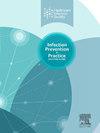Optimizing epidemic prevention in nursing homes using clinical surveillance of respiratory infections
IF 1.9
Q3 INFECTIOUS DISEASES
引用次数: 0
Abstract
Background
Respiratory tract infections (RTIs) pose a significant risk in nursing homes (NHs), which makes surveillance crucial for timely intervention.
Aim
To monitor the impacts of seasonal RTIs in NHs, which include frequency, the use of rapid diagnostic tests and antibiotics, mortality, and cluster dynamics, with the use of clinical surveillance.
Methods
During the winter periods from 2015 to 2019 (22 weeks), data on general signs (GSs), and respiratory signs (RSs) were collected to define three respiratory clinical sign patterns (CSPs): GS+/RS+, GS−/RS+, and GS+/RS−. Clusters (≥2 cases) were identified and classified into three intensity levels, namely, L1, L2, and L3 (2, 3–5, and ≥6 GS+/RS+/4 days, respectively). CSP frequencies and the 28-day all-cause mortality were calculated.
Findings
In 13 NHs (N = 3,628 resident inclusions, median age: 87.2 years), 1,538 GS+/RS+, 1,482 GS−/RS+, and 233 GS+/RS− cases were observed, with mortality rates of 8.5%, 2.8%, and 6%, respectively. Among the GS+/RS+ cases, 63% received an antimicrobials. GS+/RS+ cluster analysis identified 141 clusters with L1, 100 with L2, and 26 with L3.
A total of 209 rapid diagnostic tests for influenza were carried out, with 72.2% conducted in L2 or L3 clusters. Within clusters, the first case must be identified promptly with rapid outbreak development taking place within the first 2–3 days, and potentially less effective containment efforts following delayed detection.
Conclusion
Clinical surveillance is a comprehensive method that can be utilized for the rapid implementation of preventive measures and appropriate use of antibiotics.
利用呼吸道感染临床监测优化养老院的防疫工作
背景呼吸道感染(RTIs)在疗养院(NHs)中构成重大风险,这使得监测对及时干预至关重要。目的通过临床监测监测国家卫生系统中季节性呼吸道感染的影响,包括频率、快速诊断测试和抗生素的使用、死亡率和群集动态。方法在2015 - 2019年冬季(22周)收集一般体征(GSs)和呼吸体征(RSs)数据,定义3种呼吸临床体征(csp): GS+/RS+、GS−/RS+和GS+/RS−。对≥2例病例进行分类,并将其分为L1、L2和L3 3个强度级别(分别为2、3-5和≥6 GS+/RS+/4天)。计算CSP发生率和28天全因死亡率。13例NHs (N = 3,628例居民纳入,中位年龄:87.2岁)中,观察到GS+/RS+病例1,538例,GS - /RS+病例1,482例,GS+/RS+病例233例,死亡率分别为8.5%、2.8%和6%。在GS+/RS+病例中,63%接受了抗微生物药物治疗。GS+/RS+聚类分析鉴定出L1聚集141个,L2聚集100个,L3聚集26个。总共进行了209次流感快速诊断检测,其中72.2%是在L2或L3聚集性病例中进行的。在聚集性病例中,必须迅速发现第一例病例,在最初2-3天内迅速爆发疫情,并在发现延迟后采取可能不那么有效的遏制措施。结论临床监测是一种综合性的方法,可快速实施预防措施,合理使用抗生素。
本文章由计算机程序翻译,如有差异,请以英文原文为准。
求助全文
约1分钟内获得全文
求助全文
来源期刊

Infection Prevention in Practice
Medicine-Public Health, Environmental and Occupational Health
CiteScore
4.80
自引率
0.00%
发文量
58
审稿时长
61 days
 求助内容:
求助内容: 应助结果提醒方式:
应助结果提醒方式:


